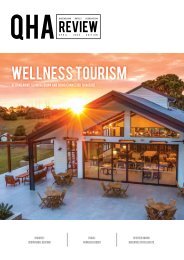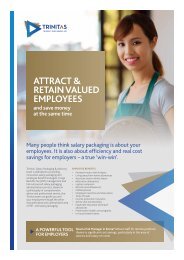QHA_February_Mag_Web
You also want an ePaper? Increase the reach of your titles
YUMPU automatically turns print PDFs into web optimized ePapers that Google loves.
EMPLOYMENT RELATIONS with Wesley Davey<br />
CHANGES TO PART-TIME AND CASUAL<br />
EMPLOYMENT IN THE HOSPITALITY INDUSTRY<br />
(GENERAL) AWARD 2010 (HIGA)<br />
<strong>QHA</strong> REVIEW | 32<br />
Changes to part-time and casual employment in the<br />
HIGA arose from the Fair Work Commission’s four<br />
yearly review of modern awards came into effect on 1<br />
January 2018.<br />
The changes to part-time employment, pursued<br />
by the AHA, <strong>QHA</strong>’s national body, make part-time<br />
employment more flexible and a viable alternative to<br />
casual employment. Existing provisions requiring set<br />
hours, starting and finishing times and days have been<br />
replaced.<br />
Meanwhile, the change to casual employment is the<br />
introduction of overtime for casual employees. This<br />
was pursued by United Voice.<br />
WHAT ARE THE KEY POINTS ON THE NEW PART-TIME<br />
PROVISIONS IN THE HIGA?<br />
• Employer and employee must agree in writing on<br />
a guaranteed minimum number of hours between<br />
eight hours and 38 hours per week (or an average<br />
of if using a roster cycle).<br />
• Employer and employee must also agree on the<br />
days and times that the employee is available to<br />
work (the availability) the guaranteed hours.<br />
• Employers must ensure the employee gets two<br />
days off each week.<br />
• If an employee is working more than the<br />
guaranteed hours, employers should make sure<br />
that those hours are rostered and within the<br />
employee’s availability, this way those hours will not<br />
be considered overtime (except if above 38 for the<br />
week or 11.5 in<br />
a day).<br />
• If an employer needs an employee to work<br />
additional hours after the roster has been posted, a<br />
discussion should be had with the employee about<br />
mutually agreeing to change the roster.<br />
For more information contact the Employment<br />
Relations Department or download our “Part time<br />
changes in the HIGA” fact sheet from qha.org.au.<br />
WHAT ARE THE KEY POINTS ON CASUAL OVERTIME?<br />
• Overtime applies where a casual works more<br />
than 12 hours in a day or shift, or after 38 hours<br />
in a week (or the average of 38 hours over a<br />
roster cycle).<br />
• Casual overtime is inclusive of the 25% casual<br />
loading, therefore to calculate overtime at all times,<br />
including on the weekend, apply the relevant<br />
overtime percentage, either 150% or 200%, to<br />
the permanent Monday to Friday base rate of pay<br />
applicable to the employee’s classification.<br />
• If casual hours fluctuate from week to week,<br />
employers could consider introducing a four-week<br />
roster cycle for averaging casuals’ hours. By doing<br />
this, overtime would only apply when an employee<br />
has worked more than 152 hours over the four<br />
weeks (provided there have not been any 12 hours<br />
plus days/shifts).<br />
• If overtime is going to occur, then the best time is<br />
when the difference between the ordinary rate and<br />
overtime rate is at its lowest. For example, the<br />
Sunday rate for a casual F & B grade 3 is $35.37<br />
and the double time rate is $40.42.<br />
For more information contact the Employment<br />
Relations Department or download the “Casual<br />
Overtime in the HIGA fact sheet” from qha.org.au.

















